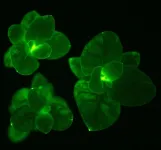(Press-News.org) For Latinx kids, unreliable access to food at age 4 raises the odds of having fatty liver disease later in childhood by nearly four times, a new UC San Francisco-led study found.
About 5% to 10% of children in the United States have nonalcoholic fatty liver disease, putting its prevalence on par with asthma. Pediatric cases have spiked in the last decade, with millions now affected by a disease marked by pain, fatigue and jaundice that can lead to cirrhosis, cancer and organ transplantation. Latinx children and adults have a higher prevalence of fatty liver disease than white or Black people, and the condition is the number one indicator for a liver transplant as an adult.
In 2022, 13.2% of children in Hispanic households had unreliable access to food (food insecurity), up from 9.7% in 2021. Nearly 16% of children in Black households had unreliable access to food in 2022, up from 12% in 2021, compared to 5.5% of children in white households in 2022, up from 3.4% in 2021.
“We’ve seen studies in adults associating food insecurity with fatty liver disease and liver fibrosis, but very few studies have looked at children,” said Sarah Maxwell, MD, a pediatrician currently completing her pediatric transplant hepatology fellowship at UCSF Benioff Children’s Hospitals and the study’s lead author. “This is especially important for Latinx children, who have both high rates of household food insecurity and fatty liver disease.”
The study was published in Pediatric Obesity.
Kids should be screened earlier
The researchers recruited two groups of Latinx mothers in San Francisco during pregnancy and followed them and their children to mid-childhood, one group from 2006-07 and the other from 2011-13. They measured food insecurity at age 4 using the U.S. Household Food Security Food Module and assessed fatty liver disease – officially called metabolic dysfunction-associated steatotic liver disease (MASLD) – between ages 5 and 12. The 136 children were followed with annual visits from birth until 2021.
Twenty-nine percent of the children had household food insecurity at age 4 and 27% had fatty liver disease in early to middle childhood. Children with fatty liver disease were more than twice as likely to live in food-insecure households (49%) at age 4 as children without fatty liver disease (21%). Food insecurity at age 4 raised the odds of having fatty liver disease by age 12 by nearly four times.
Children with overweight or obesity at age 2 also had higher risk of developing fatty liver disease in later childhood.
It’s not yet known how food insecurity leads to fatty liver disease. Past research suggests food-insecure children may have diets of poorer nutritional quality, with less produce and more sugar-sweetened beverages that directly increase fat in the liver. Household food insecurity can also cause irregular eating patterns that disrupt metabolism, leading to higher stress and greater inflammation, as well as a deterioration in the relationship between gut microbiota and the liver.
“Given our findings and how young patients are presenting with the condition to our liver clinics, we believe screening for MASLD should begin earlier than current guidelines recommend, which is age 9-11 years for children with obesity and age 2-9 years for those with severe obesity,” said Maxwell. “Food insecurity screening is also important early on, especially for Latinx children who are at higher risk and could be connected to healthier food resources in their communities.”
Ensuring that public meal programs widely available to children, such as school lunches, offer nutritious, balanced meals is also key, she added.
Funding and additional authors: Please see the paper.
About UCSF Health: UCSF Health is recognized worldwide for its innovative patient care, reflecting the latest medical knowledge, advanced technologies and pioneering research. It includes the flagship UCSF Medical Center, which is a top-ranked specialty hospital, as well as UCSF Benioff Children’s Hospitals, with campuses in San Francisco and Oakland; Langley Porter Psychiatric Hospital; UCSF Benioff Children’s Physicians; and the UCSF Faculty Practice. These hospitals serve as the academic medical center of the University of California, San Francisco, which is world-renowned for its graduate-level health sciences education and biomedical research. UCSF Health has affiliations with hospitals and health organizations throughout the Bay Area. Visit https://www.ucsfhealth.org/. Follow UCSF Health on Facebook or on Twitter
###
Follow UCSF
ucsf.edu | Facebook.com/ucsf | Twitter.com/ucsf | YouTube.com/ucsf
END
What's behind the surge of fatty liver disease in Latinx kids?
2024-03-08
ELSE PRESS RELEASES FROM THIS DATE:
nTIDE February 2024 Jobs Report: Overall employment trend still positive despite recent declines for people with disabilities
2024-03-08
East Hanover, NJ – March 8, 2024 – Despite recent declines in the labor force participation rate and employment-to-population ratio, the overall employment trend remains positive for people with disabilities, according to today’s National Trends in Disability Employment – semi-monthly update (nTIDE), issued by Kessler Foundation and the University of New Hampshire’s Institute on Disability (UNH-IOD).
Month-to-Month nTIDE Numbers (comparing January 2024 to February 2024)
Based on data from the U.S. Bureau of Labor Statistics ...
Locating single neurons that monitor and regulate the heart and lungs
2024-03-08
The body self-regulates in a process known as homeostasis, and the brain is responsible for this
as it is constantly monitoring all of the body’s vital signals. If you need more oxygen, for
example, then a message is sent to the brain that then tells the body to adjust your breathing
and your heart rate. But the neurons involved in regulating breathing and cardiac rhythm had
never been directly observed, until now, thanks to brain recording technology during brain
surgery.
EPFL neuroscientists, in a collaboration with surgeons and neuroscientists at West Virginia
University Rockefeller Neuroscience ...
Primary care scarcity linked to more surgical emergencies & problems
2024-03-08
America’s shortage of primary care doctors and nurse practitioners has a downstream effect in the nation’s operating rooms, a new study finds.
And patients suffer as a result.
In all, people living in areas with the most severe shortages of primary care providers have a much higher risk of having emergency surgery, rather than a scheduled operation,
compared with people with the same condition who live in areas with less-dire primary care shortages.Those living in the areas with the lowest availability of primary care providers ...
Novel PET tracer maps fructose metabolism to identify cardiac and neural disorders
2024-03-08
Reston, VA—A new PET radiotracer can differentiate diseased tissues from healthy tissues based on fructose metabolism, according to new research published in the March issue of The Journal of Nuclear Medicine. Fructose metabolism—or fructolysis—is indicative of a variety of diseases, and by noninvasively mapping fructolysis physicians can more accurately detect diseases and treat them earlier.
Glucose is used as the primary biochemical fuel throughout the body, powering key processes like tissue function, growth, and repair. Glucose is also consumed extensively during inflammation and cancer growth and can be visualized with PET scans. Evidence continues to mount that ...
Pushing the boundary on ultralow frequency gravitational waves
2024-03-08
A team of physicists has developed a method to detect gravity waves with such low frequencies that they could unlock the secrets behind the early phases of mergers between supermassive black holes, the heaviest objects in the universe.
The method can detect gravitational waves that oscillate just once every thousand years, 100 times slower than any previously measured gravitational waves.
“These are waves reaching us from the farthest corners of the universe, capable of affecting how light travels,” said Jeff Dror, Ph.D., an assistant ...
New study reveals molecular fingerprint of biological aging
2024-03-08
University of Pittsburgh researchers have uncovered blood-based markers linked with healthy and rapid aging, allowing them to predict a person’s biological age — how fast a person’s cells and organs age regardless of their birthdate.
The new research, published in Aging Cell, points to pathways and compounds that may underlie biological age, shedding light on why people age differently and suggesting novel targets for interventions that could slow aging and promote healthspan, the length of time a person is healthy.
“Age is more than just a number,” said senior author Aditi Gurkar, Ph.D., assistant professor of geriatric medicine at ...
Glowing flowers illuminate homes and gardens with organic light
2024-03-08
Sun Valley, ID - March 8, 2024 – Recent discoveries published in Science Advances have unveiled a native plant gene that enables researchers to more effortlessly harness the captivating glow of bioluminescent plants. This gene, which varies across different plant species, allows for the redirection of living energy into organic light. The advancement reveals the intricate inner rhythms and dynamics of plants through continuously evolving luminosity, offering a natural source of illumination for homes, gardens, and beyond.
The study received support from Light Bio, a pioneer in the development of bioluminescent plants. Light Bio is dedicated to fostering ...
Research sheds light on new strategy to treat infertility
2024-03-08
New research from Oregon Health & Science University describes the science behind a promising technique to treat infertility by turning a skin cell into an egg that is capable of producing viable embryos.
Researchers at OHSU documented in vitro gametogenesis, or IVG, in a mouse model through the preliminary steps of a technique that relies upon transferring the nucleus of a skin cell into a donated egg whose nucleus has been removed. Experimenting in mice, researchers coaxed the skin cell’s nucleus into reducing its chromosomes by half, so that it could then be fertilized ...
The brain builds emotions regardless of the senses
2024-03-08
How much do our emotions depend on our senses? Does our brain and body react in the same way when we hear a fearful scream, see an eerie shadow, or smell a sinister odor? And does hearing an upbeat music or seeing a colorful landascape bring the same joy?
In an innovative study published in Science Advances, researchers have unveiled new insights into the intricate relationship between emotion and perception.
Led by a team of Italian neuroscientists from the IMT School for Advanced Studies Lucca, and conducted in collaboration with the University of Turin, the research project investigates whether the brain employs sensory-specific or abstract codes to construct ...
Harnessing the mechanisms of fungal bioluminescence to confer autonomous luminescence in plants and animal cells
2024-03-08
In a striking new study published today in Science Advances, a team of synthetic biologists led by Karen Sarkisyan at the MRC Laboratory of Medical Sciences, have reported the discovery of multiple plant enzymes – hispidin synthases – that can perform the most complex reaction of the bioluminescence pathway. This discovery is a significant milestone towards figuring out whether plants can natively produce all the molecules required for light emission. It also means that the glow of bioluminescent plants can now be more closely aligned with their internal biology.
The technology reported in the paper is a hybrid ...




